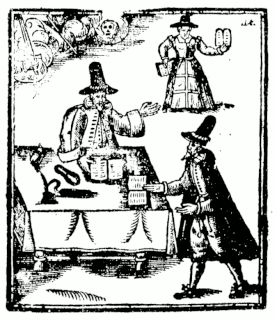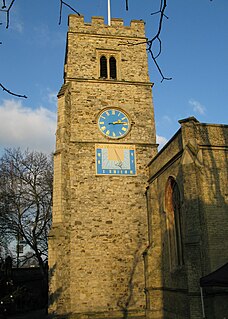
The Levellers were a political movement during the English Civil War (1642–1651) committed to popular sovereignty, extended suffrage, equality before the law and religious tolerance. The hallmark of Leveller thought was its populism, as shown by its emphasis on equal natural rights, and their practice of reaching the public through pamphlets, petitions and vocal appeals to the crowd.

Mutiny is a revolt among a group of people to oppose, change, or overthrow an organization to which they were previously loyal. The term is commonly used for a rebellion among members of the military against an internal force, but it can also sometimes mean any type of rebellion against any force. Mutiny does not necessarily need to refer to a military force and can describe a political, economic, or power structure in which there is a change of power.

The New Model Army was a standing army formed in 1645 by the Parliamentarians during the First English Civil War, then disbanded after the Stuart Restoration in 1660. It differed from other armies employed in the 1638 to 1651 Wars of the Three Kingdoms in that members were liable for service anywhere in the country, rather than being limited to a single area or garrison. To establish a professional officer corps, the army's leaders were prohibited from having seats in either the House of Lords or House of Commons. This was to encourage their separation from the political or religious factions among the Parliamentarians.

Ware is a town in Hertfordshire, England close to the county town of Hertford. It is also a civil parish in East Hertfordshire district.

Beaumont and Fletcher were the English dramatists Francis Beaumont and John Fletcher, who collaborated in their writing during the reign of James I (1603–25).

The 1648 Second English Civil War is one in a series of connected conflicts in the kingdoms of England, incorporating Wales, Scotland, and Ireland. Known collectively as the 1638 to 1651 Wars of the Three Kingdoms, others include the Irish Confederate Wars, the 1638 to 1640 Bishops' Wars, and the Cromwellian conquest of Ireland.

The Putney Debates were a series of discussions among the increasingly dominant New Model Army – a number of the participants being Levellers – concerning the makeup of a new constitution for Britain.

The Banbury mutiny was a mutiny by soldiers in the English New Model Army. The mutineers did not achieve all of their aims and some of the leaders were executed shortly afterwards on 17 May 1649.
The Corkbush Field Mutiny occurred on 15 November 1647, during the early stages of the Second English Civil War at the Corkbush Field rendezvous, when soldiers were ordered to sign a declaration of loyalty to Thomas Fairfax, the commander-in-chief of the New Model Army (NMA), and the Army Council. When some refused to do this they were arrested, and one of the ringleaders, Private Richard Arnold, was executed.
The Bishopsgate mutiny occurred in April 1649 when soldiers of Colonel Edward Whalley's regiment of the New Model Army refused to obey orders and leave London. At the end of the mutiny one soldier, a supporter of the Levellers, Robert Lockyer, was executed by firing squad.
The Agitators were a political movement as well as elected representatives of soldiers, including the New Model Army of Oliver Cromwell, during the English Civil War. They were also known as adjutators. Many of the ideas of the movement were later adopted by the Levellers.

John Fletcher (1579–1625) was a Jacobean playwright. Following William Shakespeare as house playwright for the King's Men, he was among the most prolific and influential dramatists of his day; during his lifetime and in the early Restoration, his fame rivalled Shakespeare's. He collaborated on writing plays with Francis Beaumont, and also with Shakespeare on two plays.

Colonel Robert Lilburne (1613–1665) was the older brother of John Lilburne, the well known Leveller. Unlike his brother, who severed his relationship with Oliver Cromwell, Robert Lilburne remained in the army. He is also classed as a regicide for having been a signatory to the death warrant of King Charles I in 1649. He was forty-seventh of the fifty nine Commissioners.
Colonel Sir Richard Ingoldsby was an English officer in the New Model Army during the English Civil War and a politician who sat in the House of Commons variously between 1647 and 1685. As a Commissioner (Judge) at the trial of King Charles I, he signed the king's death warrant but was one of the few regicides to be pardoned.
The Army Council was a body established in 1647 to represent the views of all levels of the New Model Army. It originally consisted of senior commanders, like Sir Thomas Fairfax, and representatives elected by their regiments, known as Agitators.
Richard Arnold may refer to:
Thomas Rawton was one of the highest-ranking officers to support the Levellers, and served with Parliament on both land and sea. He was the eldest son of Captain John Rawton, a naval officer who made his fortune in the Baltic trade, and inherited his father's property in the London Borough of Southwark.
Events from the year 1647 in England.
Saladin was a British barque that made voyages between Britain and the coast of Peru, carrying shipments of guano. The ship is best known for its demise in an act of mutiny, murder and piracy which began with the murder of its captain and officers and ended with the ship being stranded off the coast of Nova Scotia on 21 May 1844, followed by the last major piracy trial in Canada.
Enshū's Seven Kilns is a list of Japanese pottery kilns whose products were considered amongst the favourites of the Japanese tea ceremony master Kobori Enshū, who lived during the Edo period.










